- Calendar
- Online Ticket Sales
- Access
- JA
- EN
Ekin: A Genius Painter from Tosa
at the End of the Edo Period
September 10 to November 3, 2025
*There will be an exhibition change during the course of exhibition.
*Download the list of changes in works on display
*Photography is permitted for some works in this exhibition. Please refer to the venue guide for details.
*Please be advised that some works in this exhibition depict graphic scenes.
*This traveling exhibition was previously held at the Abeno Harukas Art Museum in 2023 and the Tottori Prefectural Museum in 2024.
The list of changes in worksPDF
*The order of chapters may change at the exhibition venue.
Chapter 1: Folding screens of Kabuki play by Ekin
According to a report published by the Ekingura Management Committee in 2013, about 200 folding screens of Kabuki stories still exist in Kōchi Prefecture. Many of them are in the form of two-panel folding screens, and a small number of framed are included. A few are stored in public museums, but most of them are still managed by shrines, public halls, residents’ associations, neighborhood associations, etc., because they have been displayed at shrines during the summer festivals. The custom of displaying folding screens at shrines during summer festivals was inherited even after Ekin’s death in 1876, and it is said that new folding screens were made for summer festivals even after the beginning of the Shōwa era. As a result, the individuality of Ekin and his disciples (and their disciples) can be seen in their extant folding screens. The folding screens owned by four districts of Akaoka-chō, Kōnan City (stored by Ekingura) are displayed in this chapter. They are famous as Ekin’s standard works and masterpieces. These folding screens are displayed under the eaves of the shopping district every year at the Suruda Hachimangū Shrine Festival on July 14th and 15th and the Tosa Akaoka Ekin Festival on the third weekend of July.
In addition, Ekin’s paintings of historical figures in the style of the Kanō school style, which were very characteristic of his work as an official painter serving a senior Tosa official, are exhibited in this section. It also introduces a variety of works other than folding screens on Kabuki play themes. They include picture scrolls presenting stories from Kabuki plays or annual events and an album of paintings depicting the great earthquake that struck Tosa in 1854.
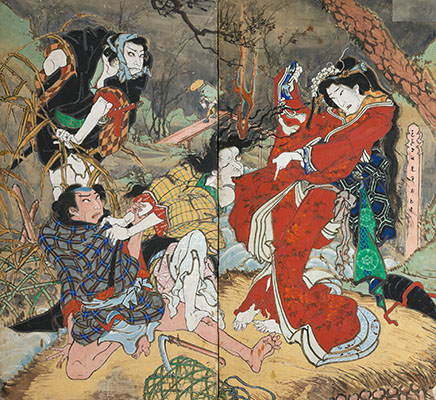
Two-panel folding screen
Honmachi 2 Ward, Akaokachō, Kōnan City
【To be shown over an entire period】
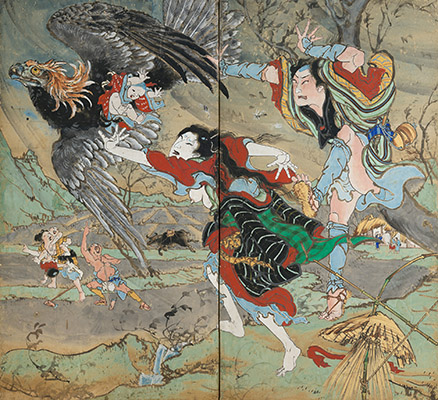
Two-panel folding screen
Honmachi 2 Ward, Akaokachō, Kōnan City
【To be shown over an entire period】
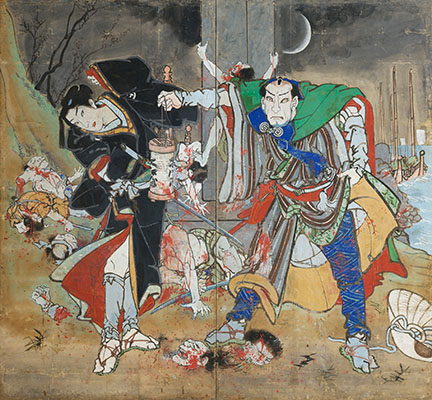
Two-panel folding screen
Honmachi 1 Ward, Akaokachō, Kōnan City
【To be shown over an entire period】
Chapter 2: Summer Festival in Kōchi
It is not clear when the custom of displaying folding screens by Ekin at shrine summer festivals began, but a folding screen storage box with the date of 1858 (Ansei 5) has been confirmed. Judging from the number of surviving folding screens, it seems that it became quite popular after the end of the Edo period. At present, we can see scenes of summer festivals adorned by Ekin’s works at about 10 shrines where folding screens are traditionally displayed on pedestals. However, due to the aging of the parishioners of the shrine and the deterioration of the condition of the folding screens, the numbers are decreasing year by year.
Six large pedestals for displaying folding screens are assembled on the approach to the shrine at the summer festival of Asakura Shrine in Asakura, Kōchi City on July 24th every year, and the sight of them lined up facing the front shrine is spectacular. Hachiōjigū Shrine in Tosa Yamada-chō, Kami City has a large pedestal Te-naga Ashi-naga Ema Dai for displaying five folding screens, which were recently exhibited at the summer festival held on July 24th and 25th, 2019. A pedestal was also assembled at the summer festival of Atago Shrine in Haruno-chō, Kōchi City on August 5th, but it was canceled in 2022. In this exhibition, the pedestals of these shrines are reproduced in the exhibition room, and the Ema lanterns, which are another feature of Kōchi’s summer festivals, are displayed. Ema lanterns, also called Andon-e, were renewed every year, so there are very few existing, and a 24-piece set of Ema lanterns Kamagafuchi Double Tomoe,Tale of Ishikawa Goemon was recently discovered.
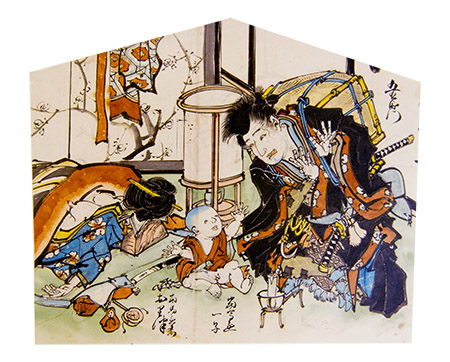
Dai-jūni
Ema paper lantern
ACT Museum
【To be shown over an entire period】
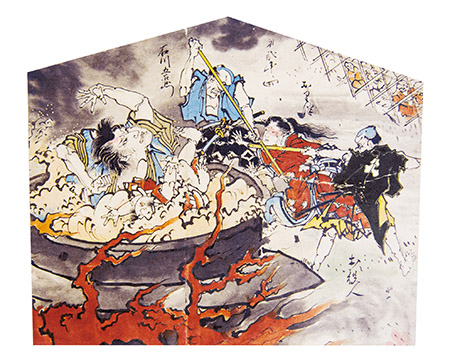
Dai-nijūshi
Ema paper lantern
ACT Museum
【To be shown over an entire period】
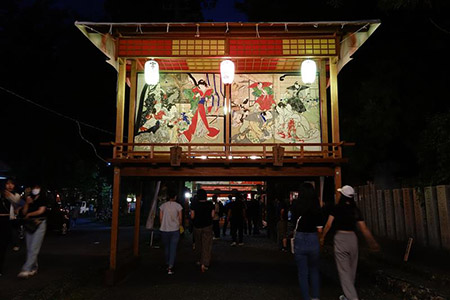
Photo taken: July 24, 2022
Chapter 3: Ekin and surrounding painters
This chapter introduces Ekin’s works other than folding screens, picture scrolls and hanging scrolls, as well as works by painters who were deeply involved with Ekin.
There were many disciples who studied under Ekin in each period of official painter and town painter. The inscription on the tombstone of Mr. and Mrs. Ekin (Yūchikusai Meoto Haka) on a mountainside in Azōno, Kōchi City reads, “Several hundred people, including disciples and those who received the skill, practiced the painting method.” Kawada Shōryō was the foremost intellectual in Tosa at the time, and presented the lord of the Tosa domain with a record of drifting, Hyōsonki Ryaku, which he wrote after hearing from John Manjirō, who had returned from the United States. He also had a relationship with Sakamoto Ryōma. Noguchi Sagan, a dyer in Noichi (currently Noichi-chō, Kōnan City), was called “Noichi Ekin” because his real name was Kinzō.
It was customary to hang a banner with a picture of a warrior or Kabuki play in front of the gate on the first boy’s festival in Tosa. Since most of them are made of paper, there are very few existing. “Yūchikusai,” one of Ekin’s names, is written on the Battle of Sasaki Moritsuna and Takatsuna: Moritsuna's War Camp along with a haiku poem. Therefore, it is a valuable work that shows the standards of Ekin.
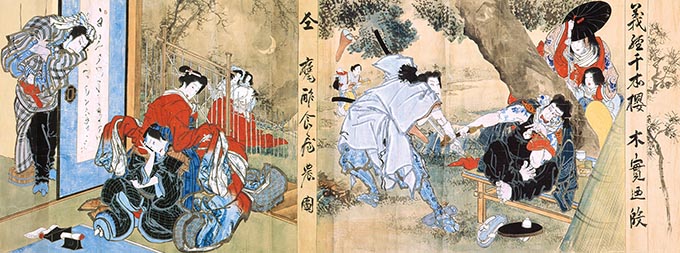
Kawada Shōryō
1857
Horizontal banner
Kōchi Prefectural Museum of History
【On display between Sep. 10 and Oct. 6】
*Unauthorized reproduction or use of texts or images from this site is prohibited.
2025 January
- Exhibition
- Closed
- Tea Ceremony
- Mon
- Tue
- Wed
- Thu
- Fri
- Sat
- Sun
- 1
- 2
- 3
- 4
- 5
- 6
- 7
- 8
- 9
- 10
- 11
- 12
- 13
- 14
- 15
- 16
- 17
- 18
- 19
- 20
- 21
- 22
- 23
- 24
- 25
- 26
- 27
- 28
- 29
- 30
- 31
2025 February
- Exhibition
- Closed
- Tea Ceremony
- Mon
- Tue
- Wed
- Thu
- Fri
- Sat
- Sun
- 1
- 2
- 3
- 4
- 5
- 6
- 7
- 8
- 9
- 10
- 11
- 12
- 13
- 14
- 15
- 16
- 17
- 18
- 19
- 20
- 21
- 22
- 23
- 24
- 25
- 26
- 27
- 28
2025 March
- Exhibition
- Closed
- Tea Ceremony
- Mon
- Tue
- Wed
- Thu
- Fri
- Sat
- Sun
- 1
- 2
- 3
- 4
- 5
- 6
- 7
- 8
- 9
- 10
- 11
- 12
- 13
- 14
- 15
- 16
- 17
- 18
- 19
- 20
- 21
- 22
- 23
- 24
- 25
- 26
- 27
- 28
- 29
- 30
- 31
2025 April
- Exhibition
- Closed
- Tea Ceremony
- Mon
- Tue
- Wed
- Thu
- Fri
- Sat
- Sun
- 1
- 2
- 3
- 4
- 5
- 6
- 7
- 8
- 9
- 10
- 11
- 12
- 13
- 14
- 15
- 16
- 17
- 18
- 19
- 20
- 21
- 22
- 23
- 24
- 25
- 26
- 27
- 28
- 29
- 30
2025 May
- Exhibition
- Closed
- Tea Ceremony
- Mon
- Tue
- Wed
- Thu
- Fri
- Sat
- Sun
- 1
- 2
- 3
- 4
- 5
- 6
- 7
- 8
- 9
- 10
- 11
- 12
- 13
- 14
- 15
- 16
- 17
- 18
- 19
- 20
- 21
- 22
- 23
- 24
- 25
- 26
- 27
- 28
- 29
- 30
- 31
2025 June
- Exhibition
- Closed
- Tea Ceremony
- Mon
- Tue
- Wed
- Thu
- Fri
- Sat
- Sun
- 1
- 2
- 3
- 4
- 5
- 6
- 7
- 8
- 9
- 10
- 11
- 12
- 13
- 14
- 15
- 16
- 17
- 18
- 19
- 20
- 21
- 22
- 23
- 24
- 25
- 26
- 27
- 28
- 29
- 30
2025 July
- Exhibition
- Closed
- Tea Ceremony
- Mon
- Tue
- Wed
- Thu
- Fri
- Sat
- Sun
- 1
- 2
- 3
- 4
- 5
- 6
- 7
- 8
- 9
- 10
- 11
- 12
- 13
- 14
- 15
- 16
- 17
- 18
- 19
- 20
- 21
- 22
- 23
- 24
- 25
- 26
- 27
- 28
- 29
- 30
- 31
2025 August
- Exhibition
- Closed
- Tea Ceremony
- Mon
- Tue
- Wed
- Thu
- Fri
- Sat
- Sun
- 1
- 2
- 3
- 4
- 5
- 6
- 7
- 8
- 9
- 10
- 11
- 12
- 13
- 14
- 15
- 16
- 17
- 18
- 19
- 20
- 21
- 22
- 23
- 24
- 25
- 26
- 27
- 28
- 29
- 30
- 31
2025 September
- Exhibition
- Closed
- Tea Ceremony
- Mon
- Tue
- Wed
- Thu
- Fri
- Sat
- Sun
- 1
- 2
- 3
- 4
- 5
- 6
- 7
- 8
- 9
- 10
- 11
- 12
- 13
- 14
- 15
- 16
- 17
- 18
- 19
- 20
- 21
- 22
- 23
- 24
- 25
- 26
- 27
- 28
- 29
- 30
2025 October
- Exhibition
- Closed
- Tea Ceremony
- Mon
- Tue
- Wed
- Thu
- Fri
- Sat
- Sun
- 1
- 2
- 3
- 4
- 5
- 6
- 7
- 8
- 9
- 10
- 11
- 12
- 13
- 14
- 15
- 16
- 17
- 18
- 19
- 20
- 21
- 22
- 23
- 24
- 25
- 26
- 27
- 28
- 29
- 30
- 31
2025 November
- Exhibition
- Closed
- Tea Ceremony
- Mon
- Tue
- Wed
- Thu
- Fri
- Sat
- Sun
- 1
- 2
- 3
- 4
- 5
- 6
- 7
- 8
- 9
- 10
- 11
- 12
- 13
- 14
- 15
- 16
- 17
- 18
- 19
- 20
- 21
- 22
- 23
- 24
- 25
- 26
- 27
- 28
- 29
- 30
2025 December
- Exhibition
- Closed
- Tea Ceremony
- Mon
- Tue
- Wed
- Thu
- Fri
- Sat
- Sun
- 1
- 2
- 3
- 4
- 5
- 6
- 7
- 8
- 9
- 10
- 11
- 12
- 13
- 14
- 15
- 16
- 17
- 18
- 19
- 20
- 21
- 22
- 23
- 24
- 25
- 26
- 27
- 28
- 29
- 30
- 31
2026 January
- Exhibition
- Closed
- Tea Ceremony
- Mon
- Tue
- Wed
- Thu
- Fri
- Sat
- Sun
- 1
- 2
- 3
- 4
- 5
- 6
- 7
- 8
- 9
- 10
- 11
- 12
- 13
- 14
- 15
- 16
- 17
- 18
- 19
- 20
- 21
- 22
- 23
- 24
- 25
- 26
- 27
- 28
- 29
- 30
- 31
2026 February
- Exhibition
- Closed
- Mon
- Tue
- Wed
- Thu
- Fri
- Sat
- Sun
- 1
- 2
- 3
- 4
- 5
- 6
- 7
- 8
- 9
- 10
- 11
- 12
- 13
- 14
- 15
- 16
- 17
- 18
- 19
- 20
- 21
- 22
- 23
- 24
- 25
- 26
- 27
- 28
2026 March
- Exhibition
- Closed
- Mon
- Tue
- Wed
- Thu
- Fri
- Sat
- Sun
- 1
- 2
- 3
- 4
- 5
- 6
- 7
- 8
- 9
- 10
- 11
- 12
- 13
- 14
- 15
- 16
- 17
- 18
- 19
- 20
- 21
- 22
- 23
- 24
- 25
- 26
- 27
- 28
- 29
- 30
- 31
2026 April
- Exhibition
- Closed
- Mon
- Tue
- Wed
- Thu
- Fri
- Sat
- Sun
- 1
- 2
- 3
- 4
- 5
- 6
- 7
- 8
- 9
- 10
- 11
- 12
- 13
- 14
- 15
- 16
- 17
- 18
- 19
- 20
- 21
- 22
- 23
- 24
- 25
- 26
- 27
- 28
- 29
- 30
2026 May
- Exhibition
- Closed
- Mon
- Tue
- Wed
- Thu
- Fri
- Sat
- Sun
- 1
- 2
- 3
- 4
- 5
- 6
- 7
- 8
- 9
- 10
- 11
- 12
- 13
- 14
- 15
- 16
- 17
- 18
- 19
- 20
- 21
- 22
- 23
- 24
- 25
- 26
- 27
- 28
- 29
- 30
- 31
2026 June
- Exhibition
- Closed
- Mon
- Tue
- Wed
- Thu
- Fri
- Sat
- Sun
- 1
- 2
- 3
- 4
- 5
- 6
- 7
- 8
- 9
- 10
- 11
- 12
- 13
- 14
- 15
- 16
- 17
- 18
- 19
- 20
- 21
- 22
- 23
- 24
- 25
- 26
- 27
- 28
- 29
- 30
2026 July
- Exhibition
- Closed
- Mon
- Tue
- Wed
- Thu
- Fri
- Sat
- Sun
- 1
- 2
- 3
- 4
- 5
- 6
- 7
- 8
- 9
- 10
- 11
- 12
- 13
- 14
- 15
- 16
- 17
- 18
- 19
- 20
- 21
- 22
- 23
- 24
- 25
- 26
- 27
- 28
- 29
- 30
- 31
2026 August
- Exhibition
- Closed
- Mon
- Tue
- Wed
- Thu
- Fri
- Sat
- Sun
- 1
- 2
- 3
- 4
- 5
- 6
- 7
- 8
- 9
- 10
- 11
- 12
- 13
- 14
- 15
- 16
- 17
- 18
- 19
- 20
- 21
- 22
- 23
- 24
- 25
- 26
- 27
- 28
- 29
- 30
- 31
2026 September
- Exhibition
- Closed
- Mon
- Tue
- Wed
- Thu
- Fri
- Sat
- Sun
- 1
- 2
- 3
- 4
- 5
- 6
- 7
- 8
- 9
- 10
- 11
- 12
- 13
- 14
- 15
- 16
- 17
- 18
- 19
- 20
- 21
- 22
- 23
- 24
- 25
- 26
- 27
- 28
- 29
- 30
2026 October
- Exhibition
- Closed
- Mon
- Tue
- Wed
- Thu
- Fri
- Sat
- Sun
- 1
- 2
- 3
- 4
- 5
- 6
- 7
- 8
- 9
- 10
- 11
- 12
- 13
- 14
- 15
- 16
- 17
- 18
- 19
- 20
- 21
- 22
- 23
- 24
- 25
- 26
- 27
- 28
- 29
- 30
- 31
2026 November
- Exhibition
- Closed
- Mon
- Tue
- Wed
- Thu
- Fri
- Sat
- Sun
- 1
- 2
- 3
- 4
- 5
- 6
- 7
- 8
- 9
- 10
- 11
- 12
- 13
- 14
- 15
- 16
- 17
- 18
- 19
- 20
- 21
- 22
- 23
- 24
- 25
- 26
- 27
- 28
- 29
- 30
2026 December
- Exhibition
- Closed
- Mon
- Tue
- Wed
- Thu
- Fri
- Sat
- Sun
- 1
- 2
- 3
- 4
- 5
- 6
- 7
- 8
- 9
- 10
- 11
- 12
- 13
- 14
- 15
- 16
- 17
- 18
- 19
- 20
- 21
- 22
- 23
- 24
- 25
- 26
- 27
- 28
- 29
- 30
- 31
